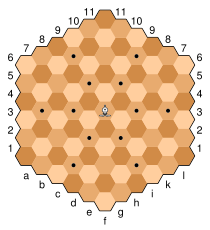Description
Invented in 1966 by Yakov Brusky, this board has 84 hexagonal cells with a different orientation from Glinski chess which leads to different pawns movements.
Each team has a classical set of pieces except there are 10 pawns and 3 bishops (hexagonal boards have 3 different colors instead of 2 like in orthodox chess)
Rules
Initial setup
84 hexagonal cells board

Pieces moves
Same move as Glinski chess (see below "Gliński's chess movements")
Differences from Glinski chess are:
- Pawns movement.
- Castling is permitted (short and long).
Pawns movement
Pawns can move forward to one adjacent cell, or 2 if first move (see green dots)
Capture is made forward in diagonal to a same-color cell, plus one same-color cell forward if first move (see red dots).

"En passant" captures are permitted.
Gliński's chess movements
The King

The Queen

The Bishop

The Rook

The Knight

The Pawn
Double step from starting position if possible. If a pawn captures from its starting cell to another pawn starting cell, it keeps its double cell start ability for another turn. See crosses for captures. "En passant" captures are possible.
Credits
Rules were invented in 1966 by Yakov Brusky.